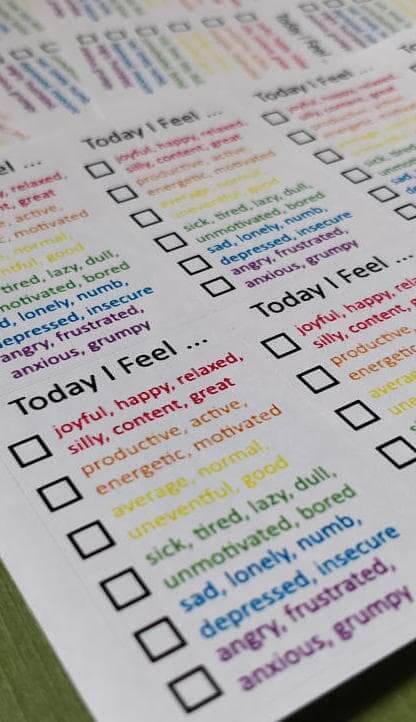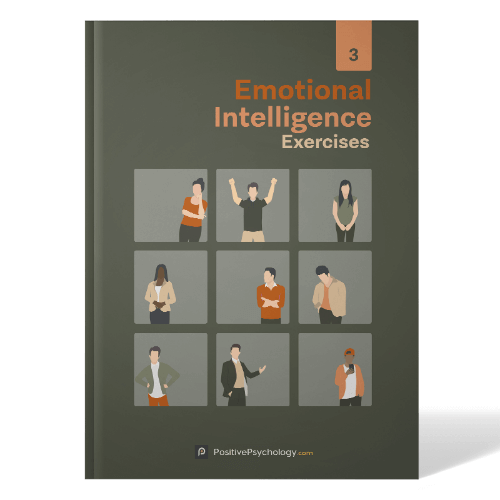7 Best Mood Trackers to Chart and Journal Your Mood (+ PDF)

You cannot manage what you do not measure.
This is true in business, health, and can even be applied to one’s personal life.
The fact is unless an individual is able to organize, analyze and process the data they’re working with, reaching an accurate conclusion can be difficult.
Firstly, because one needs to know exactly what they’re working with. And secondly, because organizing the information in an orderly log provides a more clear picture, which makes the decision-making process much easier.
When it comes to personal wellbeing, one’s mood plays an important role in determining energy levels, where attention is focused, and what actions are taken. One study suggested that:
“when participants were in a happy mood, they processed information more globally compared to when they were in a sad mood.”
(Schmid, Mast, Bombari, Mast and Lobmaier, 2011) “
This study shows that, when individuals are more positive, they gather more information from the outside world. With more information, people can make better and more clear choices, which is always a good thing.
Before you continue, we thought you might like to download our three Self-Compassion Exercises for free. These detailed, science-based exercises will not only help you increase the compassion and kindness you show yourself but will also give you the tools to help your clients, students, or employees show more compassion to themselves.
This Article Contains:
What Is A Mood Chart? And For Who Is It?
To have a better understanding of what we’re measuring when looking at moods, we can start by agreeing on a few definitions on which to build our conclusions.
There are three key terms that will assist us in the process: affect, emotions, and mood.
Affect refers to our overall feelings, which we experience throughout our days, weeks and months. Emotions arise as a result of specific events or situations. Moods, on the other hand, are the background feelings that accompany us without any particular reason or cause (Emotions and Moods, 2005).
Psychologists define mood as a number of persistent feelings that accompany our perception and evaluation of incoming stimuli. Mood has a huge influence on the way we react, specifically in the actions we take and the feelings that get created throughout that process (Amado-Boccara, Donnet, & Olie, 1993).
The tricky thing about moods is that they are transitory, and can come and go without warning, cause, or reason. This is why, unlike emotions, which arise due to, or as a result of, specific events, moods represent our overall state, and determine how we interpret or approach external stimuli. Also, they can last much longer than emotions (Moods, 2015).
One’s personality can influence the way a mood is displayed, and the actions that one takes during such phases. People who are more optimistic and positive, who gather more information from the surrounding stimuli, are able to have a better view of reality and adjust their actions according to what’s going on at that moment.
That’s why, the purposeful act of widening our attention to spot positive stimuli not only helps us maintain our positive affect, but provides us with more resources by which to refer back to it (Wadlinger & Isaacowitz, 2006).
Those who are pessimistic or insecure, look for evidence to support their downcast state and search for ways to reason or explain their negative affect (Norbert & Gerald, 1983).
This feedback loop might strengthen the negative thoughts, and prolong the experience of such negative feelings. As the incoming information from the outside world is limited to only that which agrees or supports the dominant thoughts in the mind.
Without an ability to have a more accurate view of the environment, a biased and more subjective mental state is created and maintained. This is where the tracking benefits of mood charts can provide crucial information about when, where, and how often such moods are experienced and expressed.
With enough data and information, a pattern of the highs and lows can be identified, as well as the factors that may have caused them. This tool is handy for those experiencing depression, bipolar disorder, anxiety, but also those wishing to know more about themselves.
Why It’s Good For Your Mental Health

And the way we think determines the actions we take, which in turn influences our experiences and ultimately, our feelings.
This is a good example of how connected and cyclical our systems are.
The below quote by Darwin emphasizes the connected nature of our body organs and adds some explanation to this phenomenon.
“When the mind is strongly excited, we might expect that it would instantly affect in a direct manner the heart; and this is universally acknowledged and felt to be the case. Claude Bernard also repeatedly insists, and this deserves especial notice, that when the heart is affected it reacts on the brain; and the state of the brain again reacts through the pneumo-gastric nerve on the heart; so that under any excitement there will be much mutual action and reaction between these, the two most important organs of the body.”
Darwin, 1872, p. 69.
From this, we can deduce that maintaining a positive mood ensures a balanced outlook and notably influences our wellbeing. On the other hand, being in a constant state of nervousness, where our feelings go up and down as a result of external stimuli, creates an imbalance that leads to ill-being (Desmet, Vastenburg, & Romero, 2016).
A continued mood imbalance, in either the positive or negative outlook, leads to a lopsided view of the world. Rather than seeing reality as is, and making objective decisions based on available information, individuals focus on and pick up stimuli that support their dominant thoughts and emotions. An inability to understand and express these strong feelings can cause long-term problems.
One study showed that in the wake of trauma, the habit of ruminating on the negative event, a wish to suppress its undesirable thoughts, as well as the inability to associate with that past event, so as to fully process and move beyond it, is correlated with more symptoms of traumatic behavior and their severity (Desmet, Vastenburg, & Romero, 2016).
Individuals with such poor “cognitive and emotional adaptation strategies are involved in the development of PTSD (post-traumatic stress disorder)”, as they are unable to accept the emotionally charged event, keeping it in the mind and creating discomfort. In turn, this negatively influences new experiences (Desmet, Vastenburg, & Romero, 2016).
While these avoidance strategies might be efficient in the short-term, in the long-term they prove to be quite damaging. One study showed that a continued disassociation to the traumatic event leads to emotional numbing, which manifests into a feeling of detachment to people and events that once were a source of pleasure.
This greatly lowers the person’s capacity to experience their full range of emotions (Berna et al., 2014).
The bottom line is captured by one study which showed that there is a strong correlation between the repetition of abstract thoughts and depressive moods. On the other hand, the reiteration of concrete thoughts complemented executive functions.
This means that individuals with ruminating thoughts, based on a skewed interpretation of negative events (influenced heavily by downcast emotions), lead to depression and an inability to reason clearly, causing a decline in executive operation (Philippot & Agrigoroaei, 2016).
A negative mind can lead to negative mental health. This is why tracking one’s mood can be useful not only for individuals currently suffering from mental illnesses but also for those wishing to add more balance and objectivity to their lives.
As one begins to plot and track mood patterns, the overall frequency of such moods emerges. The ability to see the number and the intensity of such dysfunctional thoughts enables the person to better understand whether their “sad mood will be a transient state or will become protracted, increasing the risk of developing clinical depression” (Steenbergen et al., 2015).
There are several tools available that organize and track moods, and other factors that influence the way we feel and think.
The Bullet Journal Mood Tracker

The name itself ‘bullet’ readily suggests what to expect from this process: clarity, organization, and effectiveness.
And the fact that creating such a tracker can be done by the individual suggests there is a lot of autonomy for the person, as they can monitor exclusively the items most applicable to them.
In many ways, it’s a part planner, as the person lists the activities they want or need to accomplish, but also part journal, as the emotions and feelings for that day can be identified.
The relationship between the activities and the emotions felt at the end of the day is what provides the data for pattern observations.
This bullet journal system was developed by Ryder Carroll, a Brooklyn-based designer. The inspiration was to provide a rapid logging process, which takes less time and effort than traditional long handwritten entries.
Carroll identifies the following building blocks of the process:
- Topics and Pages – help to easily identify the material that will be covered, with a
short and simple title, as well as page numbers. - Bullets – organize the actions and entries into: tasks, events, and notes.
- Tasks – marked by a dot, describe the work to be done. Using symbols identify
the status of that task, for example: X – task completed; > – task migrated;< – task scheduled. - Events – identified by an O, show date-related occurrences, which can range
from a positive social event to a negative personal encounter. The key is to
keep the description as objective as possible (at least at this step of the
process). - Notes – represented by a dash “-“. Here more details can be provided about the
above topics. These can include facts, thoughts, ideas, and observations. - Signifiers – any additional symbols that can provide more emotions, and
thoughts regarding the entries. For example, * – can represent urgent tasks; ! – can
provide inspirational or important information; an eye – can show things that require
further research, or discovery.
Once the organizational components have been crafted, individuals can move towards the Modules, which consist of (Carroll, 2018):
- Index – a repository of topics featured in the journal, with their relevant pages.
- Future Log – items to be done or completed in the coming months.
- Monthly Log – a bird’s-eye view of actions/events coming up that month.
- Daily Log – things to do for that day. Can be done the day of, or the night before.
Due to the flexible nature of such journals, the focus areas can differ from person to person, based on immediate needs, long-term goals, and other interests. Some common themes include: a daily log; a habit tracker (diet, sleep, physical activity, social life, and even stress levels); a mood tracker to identify the emotions and things that triggered it (ex: sadness, triggered by upsetting news, or personal events); and thoughts (ex: mantras; advise; interesting facts).
The information collected in the journal can remain private for personal use and analysis, or it can be shared with a mental health care provider when appropriate and comfortable for the client (Wong, 2017).
The Mood Ring Color Chart

This accessory was introduced in the 1970s and operates with a liquid crystal that changes color with differing temperature.
The idea behind the design was that blood flow relies on temperature and mood (ex: under stress, blood is directed toward internal organs, decreasing flow to the extremities) (Helmenstine, 2011).
The different colors represent varying states of emotion. Below are some of the colors and what they tend to represent (Mood Ring Color Chart, 2018):
- Black: Stressed/Nervous
- Dark brown: On Edge/Restless
- Dark yellow: Unsettled/Surprised
- Yellow: Creative/Imaginative
- Orange: Daring/Adventurous
- Red: High Energy/Angry
- Green: Calm/Comfortable
- Turquoise: Contentment/Peace
- Blue: Relaxed/Lovable
- Purple: Romantic/Sensual
Here are more color meanings.
5 Other Mood Charts (PDF)

All you have to do is print them and start utilizing the tools. Here is a list of a few you can work with today:
1. Daily Mood Chart
A simple chart that tracks your mood scale between 1-10 (10 being best, 1 being worst). Asks for your hours of sleep, and provides a space for comments.
2. Mood Chart
A chart built by Harvard’s Dr. Peter Brigham. The categories on this chart and more in-depth and include categories such as: Exercise/Medication; Energy/Mood; Sleep; Irritability (on a scale from 0-3); as well as an area for Events/Notes/Observations (to track triggers of the mood).
3. Daily Chart
This chart, offered by the Gateway Psychiatric Services provides a space to review Actions; Sleep (by looking at the time went to bed and time got out of bed, and total hours of sleep); Energy levels, that cause intensity or impulsivity, as well as, Slow moments of Dullness/Obsessing. As always there is a room for Events, or memory cues, for that day.
4. Mood/Sleep Chart
The saying goes – keep it simple, stupid, and that’s exactly what this chart provides. It strips down the tracking to the bare minimum of: mood level, sleep, energy level and a space for notes.
5. Do It Yourself Chart
Those wishing to use their creativity and create a personalized mood chart can use this step-by-step process provided by WikiHow. The steps are simple and straightforward. Decide the format, what you’ll be tracking, create a rating scale, determine how often you will be charting and tracking, and then start using.
Mood Journals & Mood Logs
Managing emotions is a challenge every individual faces. For some, recognizing and managing emotions can come easy, for others, not so much. Especially for individuals suffering from a mental illness, such as depression, anxiety, bipolar disorder, and others.
As the mind becomes subjective and sensitive to only a particular type of stimuli, it takes away one’s ability to objectively view and review the changing patterns of mood.
When it comes to individuals experiencing depression, the problem can be that they completely detach from their emotions. As Dr. O’Connor said (Stein, 2018):
“The emotional self has largely been lost to the depressive.”
The important thing to note, however, is that it is not the feelings and emotions themselves that are the issue, rather, it is the coping mechanisms that the individual created that are building barriers and obstacles to leading a more balanced life. In fact (Stein, 2018):
“the danger of tuning out your feelings, therapists say, is that if you lose your ability to feel painful feelings, you can also lose your ability to feel joy and vitality. The result: an emotional grayness or numbness can take over your life.”
This is why mood journals and mood logs are such necessary tools, to tracking, understanding and examining the patterns of emotions one experiences, as well as the triggers, situations, and events that cause them. Rather than just noticing a change in mood, mood journals also show the possible causes for such changes.
Equipped with this information, individuals can have concrete data to spark change and improve their habits, through the introduction of more productive coping techniques.
Mood journals are similar to bullet journals and mood charts, as they look at:
- The date and time (of the event).
- The mood change.
- External factors (surroundings, circumstances).
- Internal thoughts (the memories and thoughts being entertained by the mind).
- Suggesting how a well-adjusted person would react to the situation.
- Comparing the current mood to that of the well-adjusted person.
If journaling and writing out the information by hand takes too much time, there are more simplified Mood Logs to choose from. Including:
1. iMoodJournal
The application lets you keep notes, browse the history of your records, understand the associations between the moods and the experiences, as well as input information about sleep, medication, and even take pictures to see how your moods affect you physically.
2. Mood Diary
Here’s an even more simple chart. This one includes the day and time; mood/emotion, and comments that look at the thoughts and situations that led to it.
3. Daylio
This electronic app lets you track your mood and activities, without having to type a line of text. Just look through the list of emojis and symbols, and pick the ones that apply to you.
4. Mood-Log
This is an easy to use app that lets you pick the emotions as you’re feeling them throughout the day, or day to day, and provides a place to take notes or leave comments about the triggers that caused them.
5. Apps for Anxiety
There are also apps for other mental concerns, such as anxiety. Refinery 29 has listed 14 apps that will help you track and manage your symptoms.
For more ideas and applications, check out the list of 5 best journal and diary apps for 2018 recommended by Make Use Of.
A Take-Home Message
The mind can be a tricky thing to manage. In some moments it cooperates, and in others, it runs loose. Being more understanding of these changing emotions, and approaching them with curiosity, can make a big difference in the coping habits we utilize to deal with such ranging highs and lows.
There are many tools available at our fingertips that can empower us to take charge of our lives, simply by just noticing how we feel, and what triggered these feelings. With minimal time and effort, we can start taking note of the emotional patterns and adjust ourselves accordingly to the data that emerges.
At the end of the day, no one can take responsibility for our lives, but ourselves.
We hope you enjoyed reading this article. Don’t forget to download our three Self Compassion Exercises for free.
- Amado-Boccara, I., Donnet, D., & Olie, J. (1993). The concept of mood in psychology. Retrieved from https://www.ncbi.nlm.nih.gov/pubmed/8275897
- Berna, G., Vaiva, G., Ducrocq, F., Duhem, S., & Nandrino, J. (2014). Categorical and dimensional study of the predictive factors of the development of a psychotrauma in victims of car accidents. Retrieved from https://tel.archives-ouvertes.fr/tel-01177845/document
- Carroll, R. (2018). Getting Started – Bullet Journal. Retrieved from http://bulletjournal.com/get-started/
- Desmet, P., Vastenburg, M., & Romero, N. (2016). Mood measurement with Pick-A-Mood. Retrieved from https://pure.tue.nl/ws/files/42094497/DesmetFinalVersion.pdf
- Emotions and Moods. (2005). Retrieved from http://catalogue.pearsoned.co.uk/samplechapter/0132431564.pdf
- Helmenstine, A. (2011, February 25). Mood Ring Colors and Mood Ring Meanings. Retrieved from https://www.thoughtco.com/mood-ring-colors-and-meanings-608026
- Mood Ring Color Chart. (2018). Retrieved from https://www.pinterest.com/pin/479140847838274514
- Mood. (2015, August 12). Retrieved from https://www.goodtherapy.org/blog/psychpedia/mood
- Norbert, S., & Gerald, C. (1983). Mood, misattribution, and judgments of well-being: Informative and directive functions of affective states. Retrieved from http://psycnet.apa.org/record/1984-12290-001
- Philippot, P., & Agrigoroaei, S. (2016, August 2). Repetitive thinking, executive functioning, and depressive mood in the elderly. Retrieved from http://www.tandfonline.com/doi/full/10.1080/13607863.2016.1211619
- Schmid, P., Mast, M., Bombari, D., Mast, F., & Lobmaier, J. (2011). How Mood States Affect Information Processing During Facial Emotion Recognition: An Eye Tracking Study. Retrieved from https://econtent.hogrefe.com/doi/full/10.1024/1421-0185/a000060
- Steenbergen, L., Sellaro, R., Van Hemert, S., Bosch, J., & Colzato, L. (2015). A randomized controlled trial to test the effect of multispecies probiotics on cognitive reactivity to sad mood. Retrieved from https://pure.uva.nl/ws/files/2705937/172268_504003.pdf
- Stein, L. (2018, January 20). Depression Recovery: Keeping a Mood Journal. Retrieved from https://consumer.healthday.com/encyclopedia/depression-12/depression-news-176/depression-recovery-keeping-a-mood-journal-645064.html
- Wadlinger, H., & Isaacowitz, D. (2006). Positive mood broadens visual attention to positive stimuli. Retrieved from https://link.springer.com/article/10.1007/s11031-006-9021-1
- Wong, C. (2017, February 16). How to Use a Bullet Journal for Better Mental Health. Retrieved from https://journal.thriveglobal.com/how-to-use-a-bullet-journal-for-better-mental-health-df6c84161dee
Let us know your thoughts
Read other articles by their category
- Body & Brain (41)
- Coaching & Application (49)
- Compassion (27)
- Counseling (46)
- Emotional Intelligence (23)
- Gratitude (16)
- Grief & Bereavement (19)
- Happiness & SWB (35)
- Meaning & Values (26)
- Meditation (21)
- Mindfulness (42)
- Motivation & Goals (42)
- Optimism & Mindset (33)
- Positive CBT (24)
- Positive Communication (21)
- Positive Education (41)
- Positive Emotions (28)
- Positive Psychology (33)
- Positive Workplace (38)
- Relationships (31)
- Resilience & Coping (33)
- Self Awareness (21)
- Self Esteem (38)
- Software & Apps (23)
- Strengths & Virtues (28)
- Stress & Burnout Prevention (27)
- Theory & Books (42)
- Therapy Exercises (30)
- Types of Therapy (53)




What our readers think
I found your blog really really useful. This is very informative and genuine blog.cheers for writing this blog.
We appreciate you sharing your informative and simple-to-read blog with us. This post is excellent. You are one of the best bloggers I have read, I must say. I appreciate you publishing this useful article.